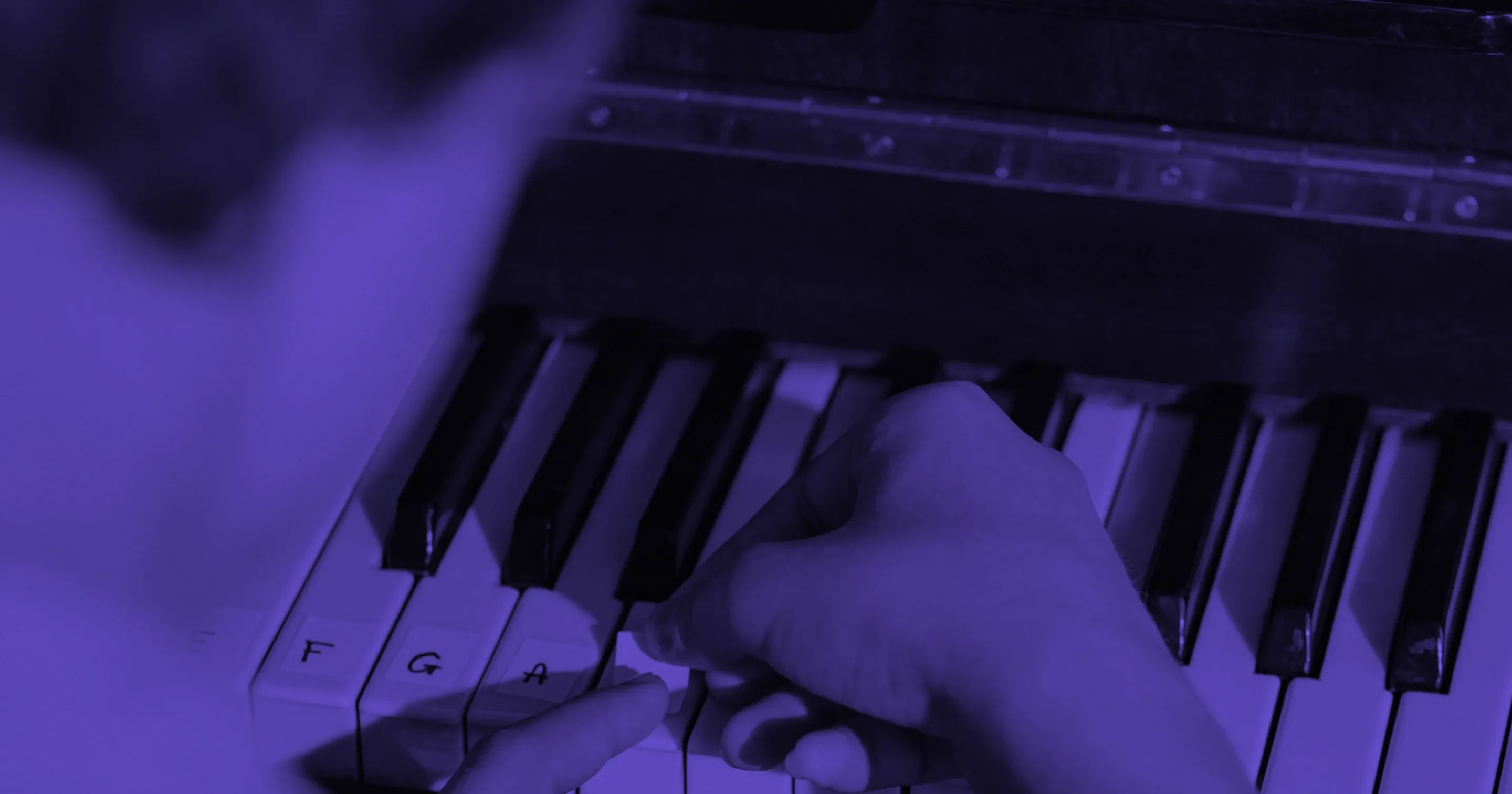
Learn the Chords in C Major: A Music Theory Resource
Explore the chords in C major and common chord progressions in C major. Written for music producers seeking to enhance their melodic and harmonic skills.
Introduction
A deep knowledge of the chords within a key is a superpower for any songwriter or producer. It transforms guesswork into intention, allowing you to build harmonies that are not only “correct” but also compelling and emotionally resonant. This guide is designed to give you that power for one of the most fundamental keys in all of music: C Major.
We will journey from the ground up, starting with the simple notes of the C Major scale and building the seven diatonic chords that form the key's natural landscape. Then, we’ll venture beyond the basics to explore how chromatic notes and borrowed chords can add unexpected color and sophistication to your progressions.
This guide will equip you with the tools to:
- Master the C Major Scale: Understand its structure and see why it’s the bedrock of Western .
- Command the Diatonic Chords: Learn the name, function, and feel of every chord naturally found in C Major.
- Build Richer Harmonies: Discover how to incorporate non-diatonic tones into your music to create more complex and memorable compositions.
By the end, you won't just know the chords in C Major; you'll understand how they work. You'll be ready to move freely within the key, crafting progressions that perfectly capture your musical vision.
The Basics of the C Major Scale
The C Major scale is made up of the seven notes C, D, E, F, G, A, and B. They form the foundation for all chords and progressions in the key of C Major. These diatonic notes are derived from a specific pattern of whole and half steps that creates the characteristic sound of the major scale.

This exact pattern is also known as the Ionian mode, the first of the seven musical modes. For a clear and engaging explanation of all the modes and how they relate to the major scale, be sure to explore our comprehensive guides on musical modes.

Each note of the scale holds a specific position or scale degree, which defines its relationship to the tonic (C) and determines its harmonic function. A diatonic chord is built on each of these degrees.
In C Major, the scale degrees and their corresponding triads are:
- C - Tonic (1st degree) - I (C Major chord)
- D - Supertonic (2nd degree) - ii (D minor chord)
- E - Mediant (3rd degree) - iii (E minor chord)
- F - Subdominant (4th degree) - IV (F Major chord)
- G - Dominant (5th degree) - V (G Major chord)
- A - Submediant (6th degree) - vi (A minor chord)
- B - Leading Tone (7th degree) - vii° (B diminished chord)
Understanding these scale degrees and the chords they produce is the first step to mastering harmony in the key of C Major.
Our blog features in-depth music theory tutorials covering all key signatures. Check it out to deepen your understanding of music.
C Major Chords and Their Functions in Music
The chords in C Major are constructed using the fundamental principle of tertian harmony, which means they are built by stacking notes in intervals of thirds. The most common type of chord, a triad, consists of three notes:
- Root: The foundational note that gives the chord its name (e.g., C is the root of a C Major chord).
- Third: This interval determines the chord's quality. A major third above the root creates a major chord, while a minor third creates a minor chord.
- Fifth: This note adds stability and harmonic depth to the triad
There are seven diatonic chords in C Major, each built from one of the notes of the C Major scale. These are the chords that naturally occur within the key. In this section, we’ll explore each of these chords and their function within a musical context.
The diatonic chords in C Major are: C Major, D minor, E minor, F Major, G Major, A minor, and B diminished.

This section explores these C Major chords, their functions, and how they are commonly used in song progressions. The piano keyboard provides a perfect visual aid for understanding C Major, as its diatonic notes are all the white keys, making chord construction and identifying any non-diatonic (black key) alterations simple and clear.
I: C Major (Tonic)
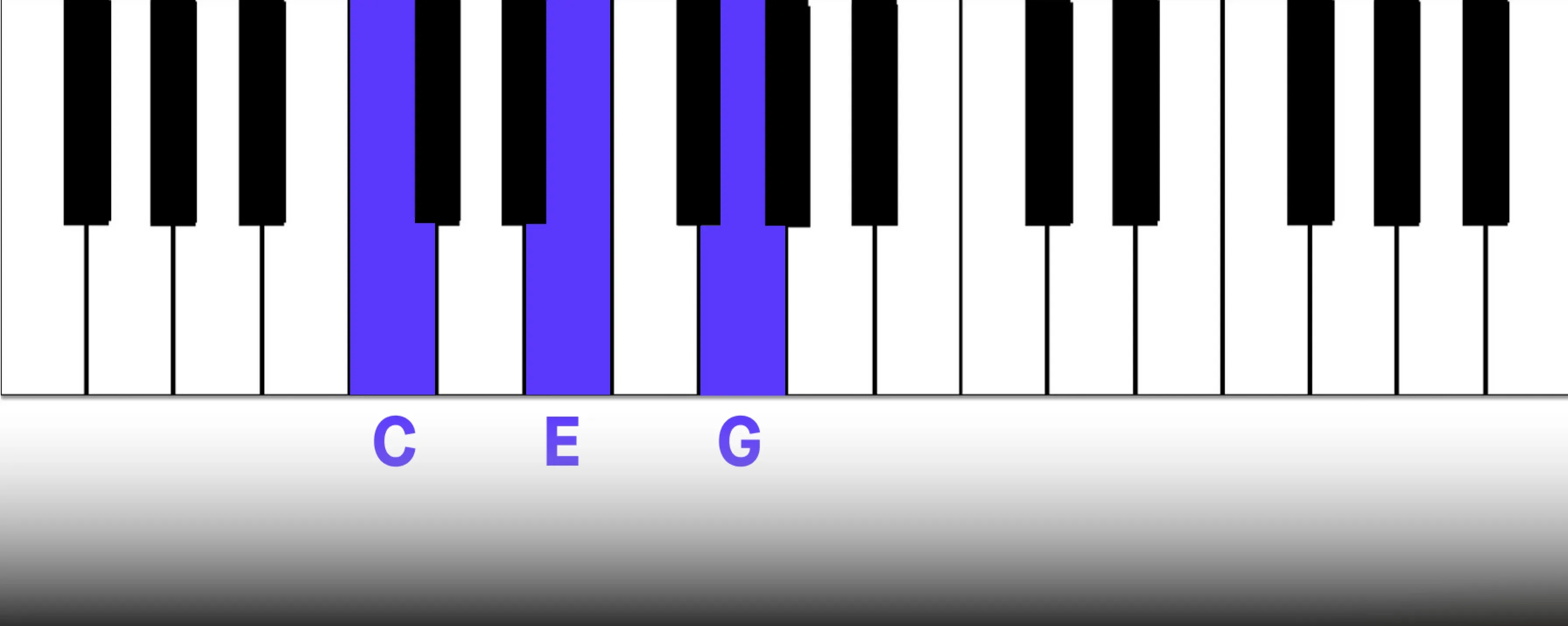
The C Major chord is the tonic (I), serving as the harmonic"home base"and foundation of the key. As the most stable chord, it provides the strongest sense of resolution and rest. While other chords create tension and drive the music forward, the tonic feels complete on its own. It is the anchor of the key's harmonic structure and the ultimate point of arrival for your chord progressions.
Example: A good illustration of this is found in John Lennon's "Imagine". The song's iconic piano introduction revolves around the C Major chord (and its Cmaj7 variation), immediately establishing a peaceful and stable tonal center before the progression moves to other chords.
ii: D Minor (Supertonic)
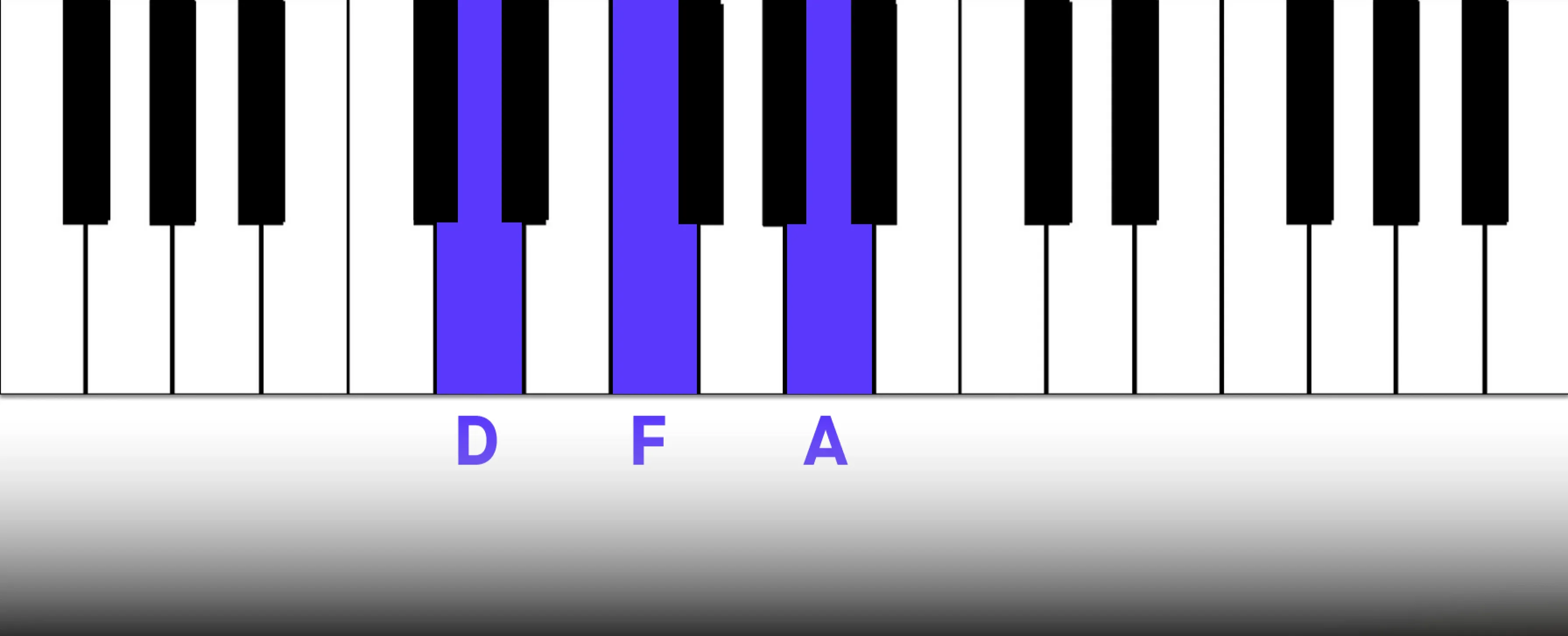
The D minor chord is the supertonic (ii), the first minor chord in the diatonic series of C Major. It provides a gentle but noticeable contrast to the stability of the tonic C Major, often adding a touch of melancholy or introspection to a progression.
Its most important and common function is to act as a predominant chord. This means it perfectly sets up the tension of the dominant (V) chord. The movement from D minor to G Major creates a powerful sense of forward momentum, pulling the listener's ear toward the eventual resolution back to C Major.
This ii-V-I relationship (Dm-G-C) is one of the most fundamental and satisfying progressions in all of music, forming the harmonic backbone of countless songs across pop, rock, and particularly in jazz chord progressions.
Example: There is no shortage of jazz songs that use the ii-V-I progression. One notable example is “Giant Steps” by John Coltrane, which mainly revolves around these three chords. “I Want You Back” by Jackson 5, “Super Trouper” by ABBA, and “A Journey In The Dark” by Howard Shore (from Lord of the Rings) also all feature the ii-V-I progression in different ways.
iii: E Minor (Mediant)
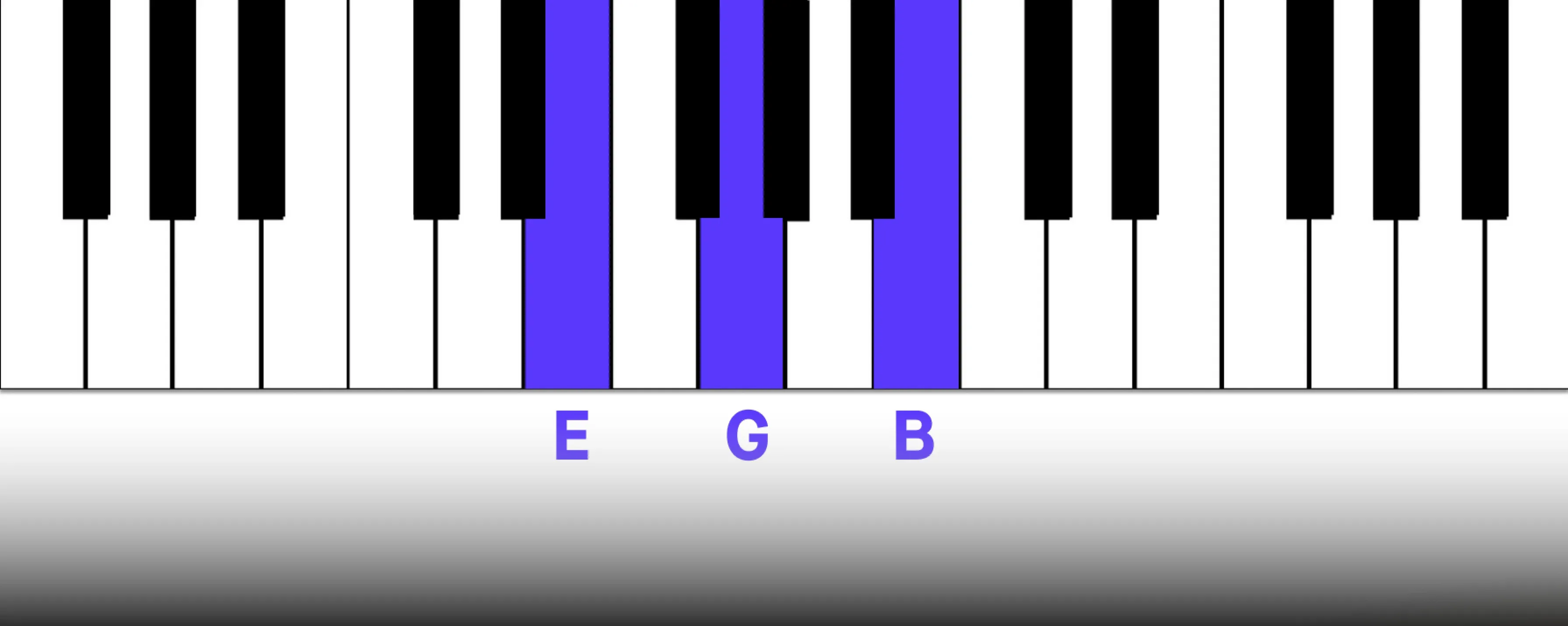
The E minor chord is the mediant (iii) in the key of C Major. It has a unique relationship with the tonic, often functioning as a tonic substitute. While it provides a sense of rest, it introduces a different harmonic color and a more reflective or somber mood compared to the bright C Major chord.
This substitution works so well because the E minor chord (E-G-B) shares two of its three notes with the C Major tonic (C-E-G). These common tones – E and G – create a strong sense of familiarity, allowing the progression to shift its character subtly without losing its connection to the home key. Using the mediant in place of the tonic is an excellent way to add emotional depth and prevent predictable resolutions.
Example: A perfect example can be heard in the main riff of"Use Somebody"by Kings of Leon. The progression moves from C → Em (I → iii), and that immediate shift from major to minor creates the song's signature yearning and introspective atmosphere. It feels like a continuation of the tonic, but with a different emotional weight.
IV: F Major (Subdominant)
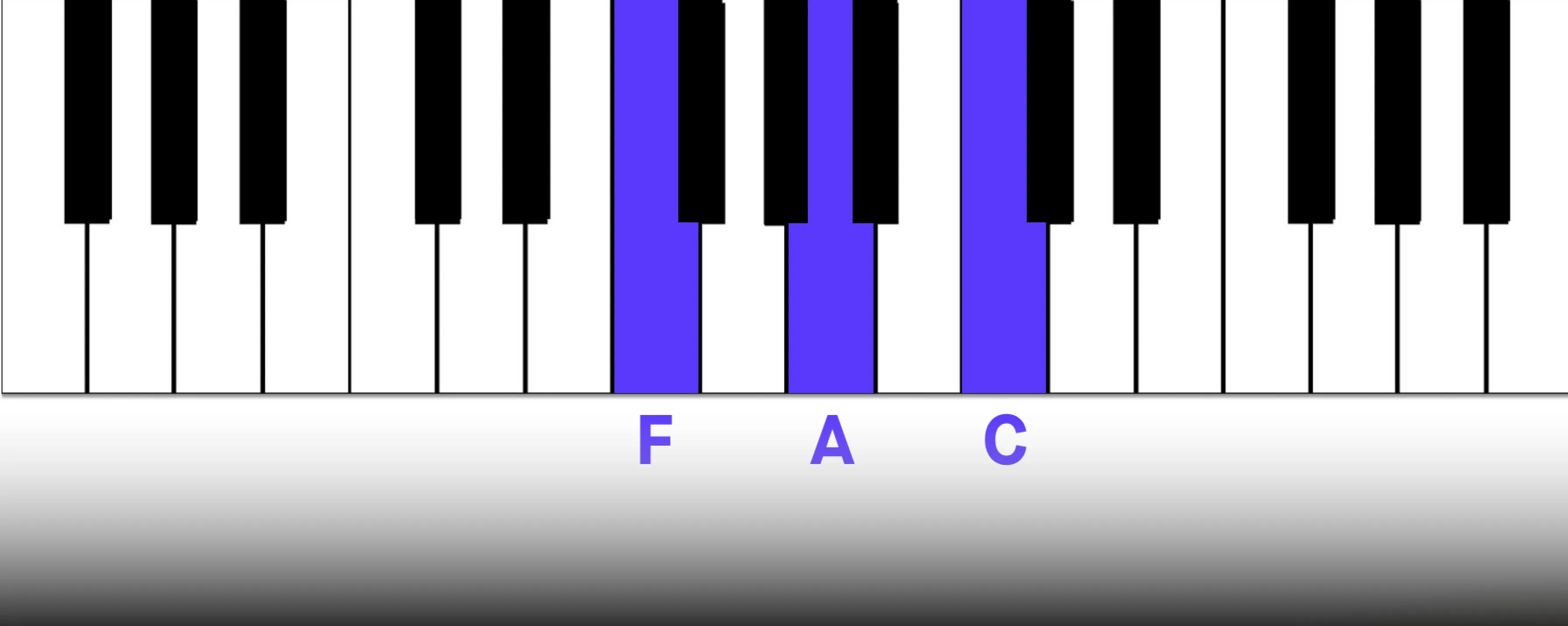
The F Major chord is the subdominant (IV) of C Major. Its primary role is to create harmonic contrast by pulling the music away from the tonic's stability. It creates a sense of departure and open-ended movement, setting the stage for other chords to follow.
The subdominant's most common function is as a pre-dominant chord, meaning it leads perfectly to the dominant (V). The progression from F Major → G Major (IV → V) is one of the most powerful ways to build tension and anticipation. This movement heightens the listener's expectation for a resolution back to the tonic, C Major, making the IV – V – I cadence a cornerstone of popular music.
Example: “La Bamba” by Ritchie Valen uses the simple and harmonically stable I – IV – V for its memorable hook. “All the Small Things” by Blink-182 and “Piano Man” by Billy Joel both feature satisfying and cyclical chord progressions, descending from the V chord to the IV chord, and then back to the I.
The chorus to “Ain’t Too Proud to Beg” by The Temptations alternates between the tonic and subdominant, showcasing the IV chord’s harmonic departure from the tonic.
V: G Major (Dominant)
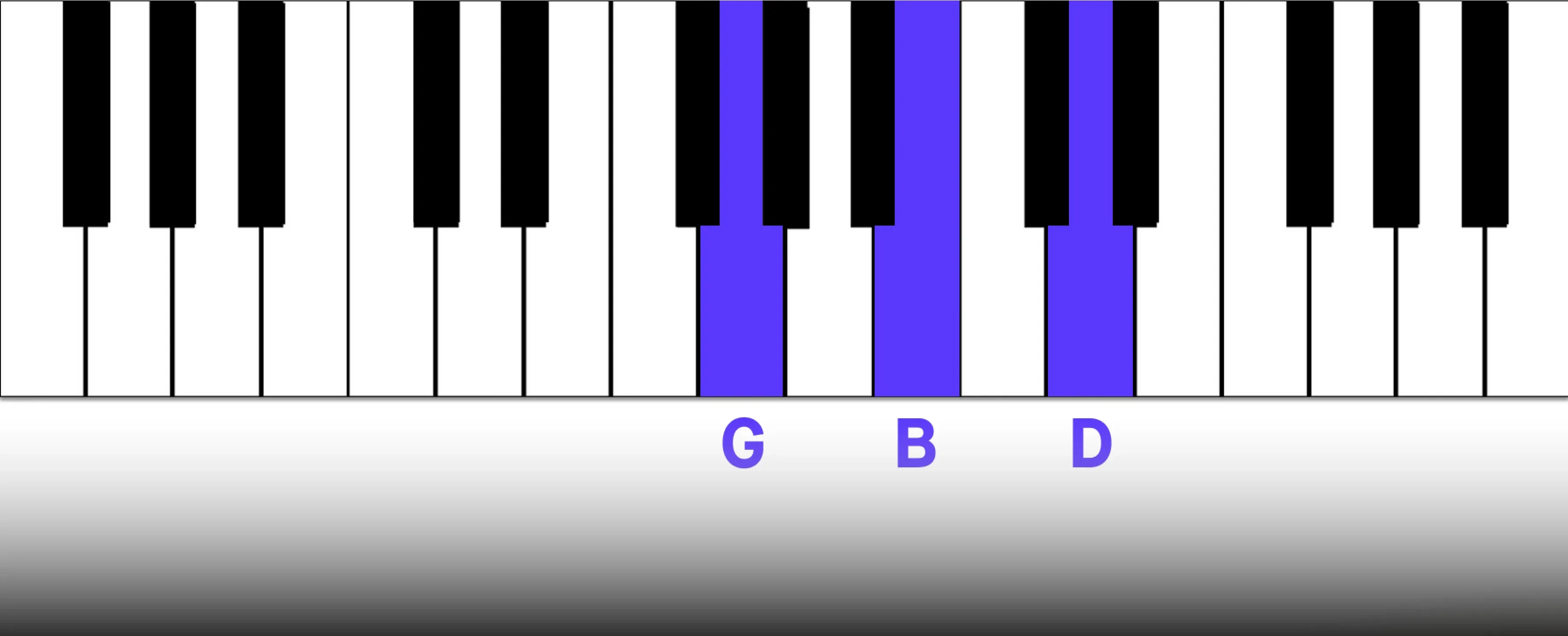
Alongside the tonic, the G Major chord is the most crucial chord in the key of C Major. One of its primary functions is to create powerful harmonic tension and demand resolution back to the tonic (C), which in turn defines the key's tonal center.
The G Major chord's inherent tension is dramatically increased when it's played as a dominant seventh chord, or G7. By adding a minor seventh to the triad, we get the notes G-B-D-F. This creates a dissonant interval known as a tritone between the third (B) and the seventh (F). This dissonance makes the chord feel highly unstable and gives it an even stronger pull toward the tonic.
Furthermore, the third of the G Major chord – the note B – is the leading tone of the C Major scale. Because it sits just a half-step below the tonic note C, it creates a strong melodic pull, making the listener instinctively expect a resolution upwards to C.
The dominant chord is most often used to precede the tonic at the end of a musical phrase, with the G → C (V → I) movement creating the strongest sense of closure in music. When a phrase begins with this movement, it generates immediate energy and direction, as the unresolved tension of the G chord creates instant forward momentum.
Example: The iconic chorus of "Twist and Shout" heavily relies on the dominant chord, building tension before resolving back to the tonic. This creates a perfect loop of energy. “Brown Eyed Girl” by Van Morrison concludes each verse with a dominant chord, which perfectly leads back to the tonic and naturally restarts the simple yet effective I – IV – I – V progression once again.
vi: A Minor (Submediant)
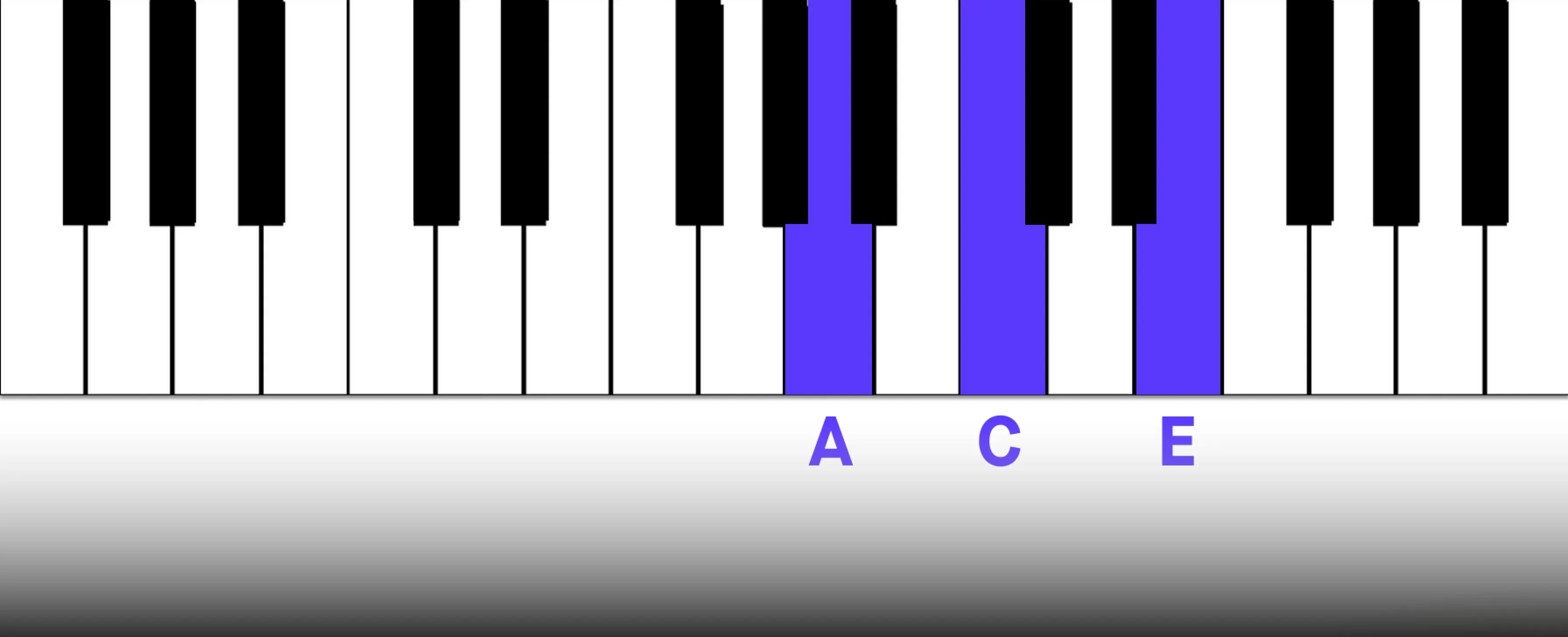
The A minor chord is the submediant (vi) in the key of C Major and is one of the most versatile and important chords in the key. It adds a distinct and valuable color, often introducing a more reflective, somber, or introspective quality compared to the key's major chords.
Its most critical role is that it is the tonic of C Major's relative minor key. This dual identity makes it a powerful tool for shifting the emotional mood of a song without leaving the key signature. Because A minor (A-C-E) shares two notes with the C Major tonic (C-E-G), it can also function as a gentle substitute for the tonic, providing a sense of stability while adding harmonic variety. This makes it invaluable for creating contrast and depth in songwriting.
The movement to the vi chord is often used to create a deceptive cadence, where the listener expects the dominant (V) chord to resolve to the tonic (I) but is instead surprised with a resolution to the submediant (vi).
Example: Bruno Mars’ “When I Was Your Man” is in C major, but starts on the relative minor chord A minor. It heavily relies on the minor vi, minor iii, and minor ii chords to emphasize the regret, sadness, and yearning of the lyrics. We know the song is not in A minor, but in C Major due to the use of the major V chord to build anticipation and create tension.
vii°: B Diminished
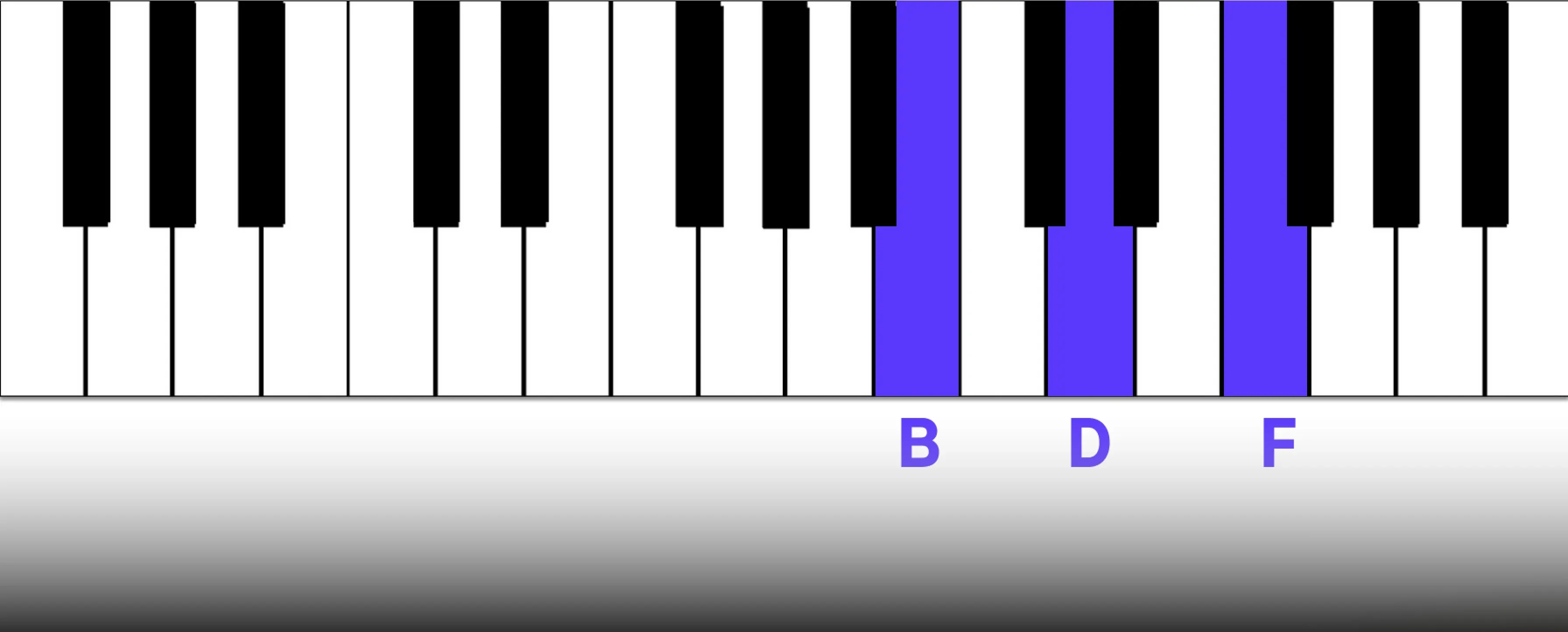
The final diatonic chord is B diminished (vii°). This chord is built on the seventh degree of the scale, the note B, which is known as the leading tone. The B diminished chord (B-D-F) is inherently unstable and dissonant because it contains a tritone interval.
Its primary function is to create a strong sense of tension that pulls urgently back to the tonic, C Major. The root of the chord, the leading tone B, is only a half-step away from the tonic C, creating an almost magnetic pull toward resolution. For this reason, it can function as a substitute for the dominant (V) chord, providing a different flavor of tension before returning to the tonic.
However, the three notes that make up the diminished vii chord are also in the Dominant 7th chord on the fifth scale degree. For that reason, it’s more common to use the dominant chord than the vii°. Instead, the diminished chord tends to be used as a passing chord, connecting one chord with the next.
Endless Opportunities With Only 7 Chords
With just these seven diatonic chords, you have the complete harmonic toolkit to write countless melodies and progressions in the key of C Major. From the stability of the tonic and the tension of the dominant to the somber color of the minor chords, these relationships are the foundation of Western music. By understanding how they work together, you can move from guesswork to writing music with confidence and intention.
If you're looking for extra help to bring your ideas to life, Musiversal offers expert songwriting and production services through the Unlimited Subscription. And if you need a creative spark to get started, check out our guide,"30 Unique Songwriting Prompts to Craft Your Next Big Hit".
Adding Depth and Complexity to Chords in C Major
Introduction to Seventh Chords in C Major
Moving beyond basic triads, seventh chords enrich your harmony by adding a new layer of complexity and emotional color. These four-note chords are built by stacking another interval of a third on top of a triad, creating a more nuanced and expressive sound. When constructed using only the diatonic notes of a major key, you will find four primary types of seventh chords: Major 7th, Minor 7th, Dominant 7th, and Half-Diminished 7th.
Each seventh chord has a distinct character:
- Major 7th Chords (maj7): A major triad with a major seventh on top. These chords sound bright, thoughtful, and serene. They can provide a sense of resolution, though the added seventh gives them a more "airy" or contemplative quality than a simple major triad.
- Minor 7th Chords (m7): A minor triad with a minor seventh. These chords are mellow, introspective, and versatile. They add emotional depth and are a staple in genres from jazz and R&B to folk and pop.
- Dominant 7th Chords (7): A major triad with a minor seventh. Dominant 7th chords are the powerhouses of harmonic tension. The dissonant tritone interval between the third and the seventh creates a strong pull that demands resolution, making these chords crucial for driving a progression forward and establishing the key.
- Half-Diminished 7th Chords (m7b5): A diminished triad with a minor seventh. As their name suggests, these chords create a unique blend of tension and ambiguity. They sound unstable and mysterious, often used to add a touch of drama before transitioning to another chord. They are commonly notated as "m7b5" (minor seven flat five).
The strategic use of these seventh chords allows you to write more intricate and emotionally engaging music by adding a richer palette of harmonic colors to your progressions.
For a more detailed guide on Seventh Chords in C Major, take a look at our article “A Comprehensive Tutorial on Creating Seventh Chords in C Major “.
Learn about the diatonic and chromatic chords in C Major with audio and notation examples in this next section. If you're unfamiliar with reading sheet music, there are many excellent beginner music theory courses and resources available online that can serve as a great starting point.
The Diminished Chord
A diminished triad is a highly dissonant and unstable chord built with a root, a minor third, and a diminished fifth (a perfect fifth lowered by one half-step). This "flattened" fifth creates a tense interval with the chord's root known as a tritone. This specific interval is what gives diminished chords their characteristically jarring and unsettled sound.
This built-in dissonance is not a weakness; it's the chord's greatest strength. The strong desire for resolution makes diminished chords incredibly expressive tools. They are perfect for conveying a range of emotions from suspense and unease to high drama, often by creating a powerful pull toward a more stable resolving chord.
Natural Occurrence in the Major Scale
In any major key (Ionian mode, specifically), a diminished triad occurs naturally on the seventh degree of the scale (vii°). In the key of C Major, this is the B diminished chord.
This B diminished chord shares two of its three notes (B and D) with the dominant 7th chord, G7 (G-B-D-F). This strong connection allows the vii° chord to function as a substitute for the dominant, creating a very similar and powerful pull towards the tonic, C Major.
Functions of Diminished Chords
Diminished chords are excellent tools for creating dissonance, suspense, and drama in your music. While they are a staple of jazz harmony, they can be used in any genre to add expressive color and complexity to a chord progression.
In C Major, the B diminished chord primarily serves two key functions:
- Heightening Tension and Anticipation: As the "leading-tone chord", its root note (B) is only a half-step away from the tonic (C). This melodic tension, combined with the chord's inherent harmonic instability due to the tritone interval, creates an urgent desire for resolution, thereby enhancing the emotional impact when the music returns to the stable C Major chord.
- Creating Smooth Transitions: Another role of the diminished chord is to lead directly to the tonic (vii° → I). It acts as a powerful dominant-function chord, creating a dramatic and satisfying resolution. Additionally, chromatic diminished chords (those built on notes outside the key) are often used as smooth passing chords between two diatonic chords, such as using a C# diminished chord to connect C Major and D minor.
Adding Variety with Chromatic Diminished Chords
Beyond their diatonic function, diminished chords offer a wealth of creative possibilities. A particularly effective technique is to chromatically alter a chord that would typically be major or minor, transforming it into a diminished chord to create a moment of unexpected color and tension.
You can also create a chromatic movement by using a passing chord between two chords.
This momentary harmonic destabilization can be used to create smooth transitions and inject sophisticated harmonic interest into otherwise conventional progressions.
In the example below, we use a chromatic diminished chord by raising the G to G#. This increases the tension before resolving it to a more consonant chord on the sixth scale degree.
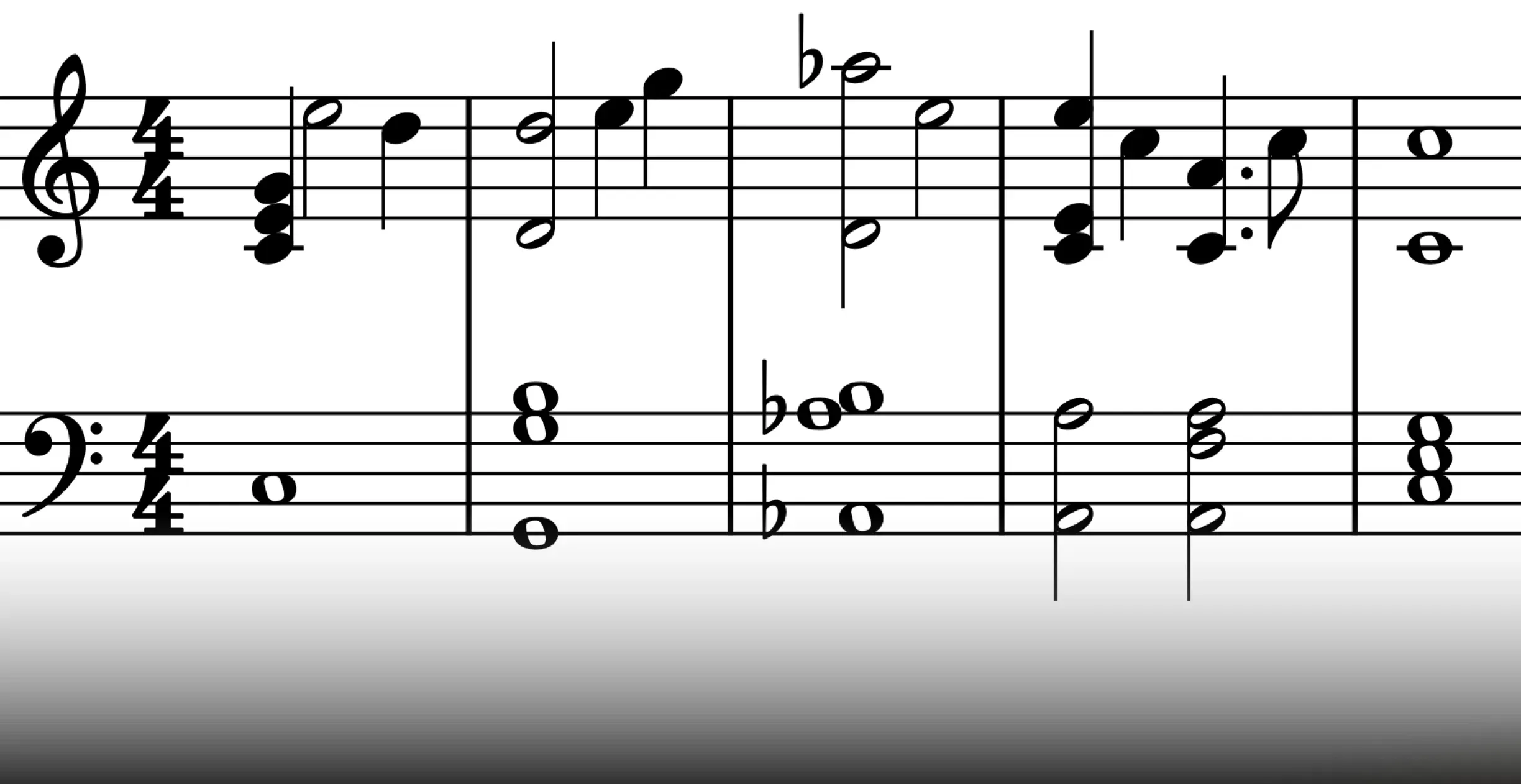
Chords: C - G - G#° - Am - F - C (I - V - #V° - vi - IV - I)
By adding the G# diminished chord, we create a chromatic bassline that walks smoothly upwards (G → G# → A). This passing chord adds a touch of jazzy sophistication and momentary tension, and arriving at the A minor chord feels even more deliberate and satisfying.
A thorough understanding of how to use both diatonic and chromatic diminished chords empowers you to write more compelling and emotionally resonant music, moving beyond basic harmony to craft truly memorable progressions.
The Augmented Chord
The augmented chord is a triad built from a root note, a major third, and an augmented fifth (a perfect fifth raised by one half-step). You can also think of it as two major thirds stacked on top of each other. Like diminished chords, augmented triads do not occur naturally within the diatonic chords of a major key, so using them requires chromaticism – the introduction of notes from outside the key.
This chromatic alteration gives the augmented chord its characteristic dissonant sound: a sense of unresolved, ambiguous tension that is different from the pull of a dominant or the instability of a diminished chord. Their inclusion allows producers and composers to add complexity, create unexpected harmonic shifts, and generate a strong desire for resolution.
In the example below, inspired by"Mamma Mia"by ABBA, we gain a sense of the mysterious and ambiguous nature of the augmented chord.
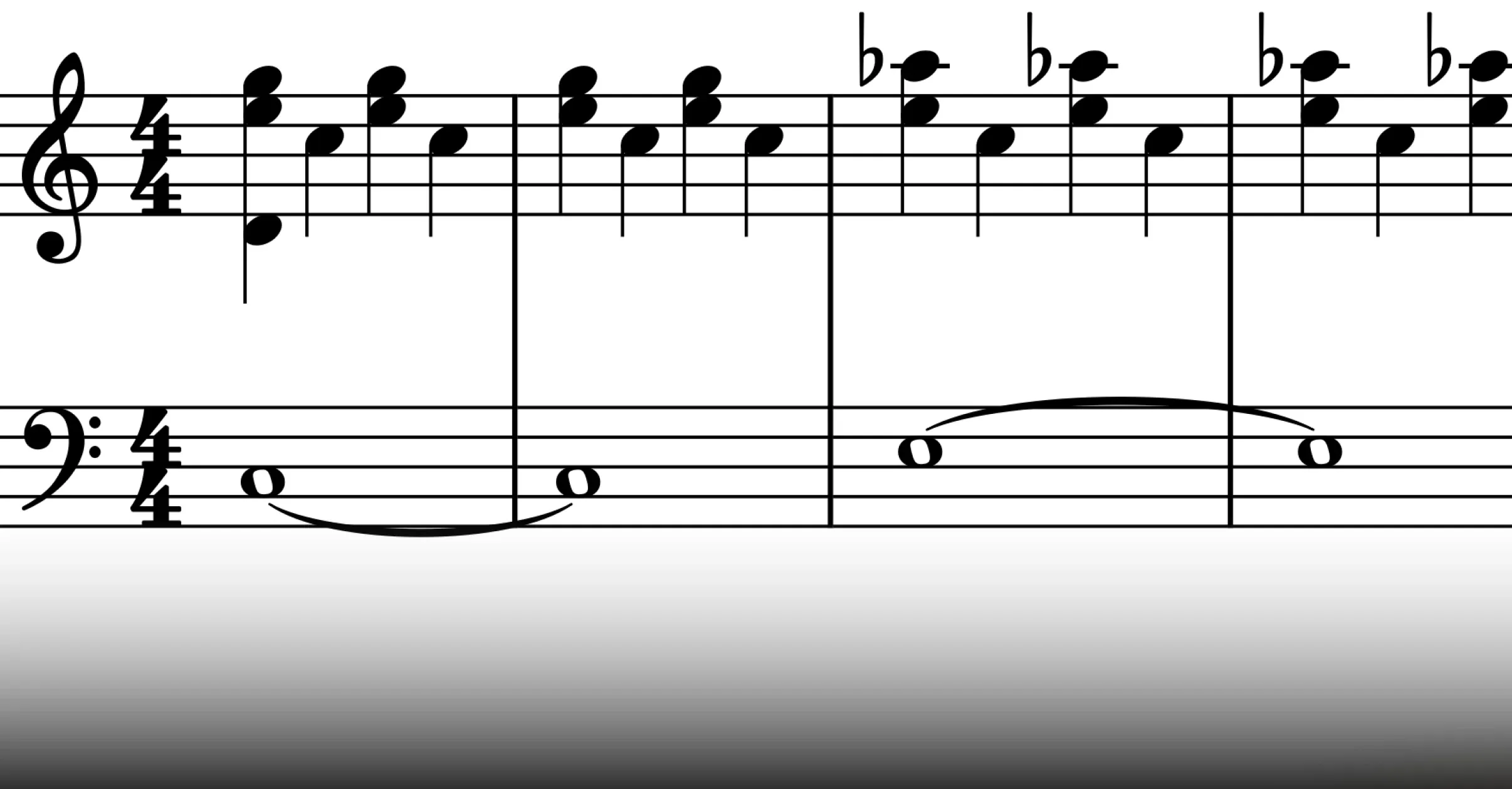
Chords: C - Caug
Uses and Functions of Augmented Chords
While augmented chords are not diatonic to the key of C Major, they can be strategically inserted to create moments of heightened tension and sophisticated resolutions. Two common applications highlight their unique character:
1. Dominant to Tonic Resolution (V+ → I)
Placing an augmented triad on the dominant scale degree and resolving it to the tonic creates a powerful sense of arrival. In C Major, this means using a G augmented chord before resolving to C Major.
- Example: In a C – G – C progression, you can alter the G chord to create C – Gaug – C.
- Why it works: The augmented fifth of the Gaug chord (D#) feels highly unresolved and naturally pulls upwards by a half-step to the note E, which is the third of the C Major tonic chord. This creates an incredibly smooth and satisfying voice-leading effect.
2. Tonic to Subdominant Progression (I+ → IV)
Using an augmented triad on the tonic and resolving it to the subdominant creates a different but equally compelling harmonic effect.
- Example: In a C – F progression, you can insert a C augmented chord to create C – Caug – F.
- Why it works: The augmented fifth of the Caug chord (G#) pulls smoothly upwards by a half-step to the note A, which is the third of the F Major subdominant chord. This adds a moment of instability to the otherwise solid tonic, making the resolution to the subdominant feel like a pleasing release of tension.
While augmented chords are unstable, they offer several valuable musical functions that can elevate your progressions:
3. Enabling Modulation to Other Keys
The ambiguous nature of augmented chords makes them useful tools for modulation. Because they don’t clearly belong to any single key, their notes can be reinterpreted to pivot into a new tonal center.
Suspended Chords (Sus Chords)
Suspended chords, or"sus"chords, create a unique feeling of harmonic ambiguity by replacing the third of a chord – the note that defines it as major or minor – with a different note. This"suspends"the chord's identity, creating an open, unresolved sound.
There are two main types:
- sus2 Chords: The third is replaced by the major second. For a C Major chord (C-E-G), a Csus2 would be C-D-G.
- sus4 Chords: The third is replaced by the perfect fourth. For a C Major chord (C-E-G), a Csus4 would be C-F-G.
Because they lack a third, sus chords don't have the clear emotional direction of traditional major or minor triads. This ambiguity makes them incredibly versatile, perfect for creating ethereal and dreamy soundscapes, moments of suspense, or gentle, floating textures.
Key Functions of Sus Chords
- Creating Anticipation: True to their name, sus chords generate harmonic tension. They are often resolved to their major or minor counterparts, creating a satisfying release. For instance, playing a Gsus4 chord before it resolves to a G Major chord builds anticipation before the dominant chord fully arrives.
- Adding Color and Texture: Sus chords can be used to add subtle harmonic variation to a standard progression, preventing it from sounding monotonous. In the progression C – G – Am – F, you could play it as Csus2 – C – Gsus4 – G – Am – F to add movement and nuance.
- Prolonging Dominant Tension: The Vsus4 chord is especially useful. A standard G7 dominant chord creates tension with the tritone between B and F. By playing a Gsus4 first, you create a different kind of tension – one of floating anticipation – before introducing the tritone. The progression Gsus4 → G → C (Vsus4 → V → I) is a classic way to delay and then heighten the final resolution to the tonic, making it feel even more powerful and complete.
In the following example, we use an augmented tonic to establish a sense of ambiguity before passing through F major, then Gsus4, G9, and finally C major.
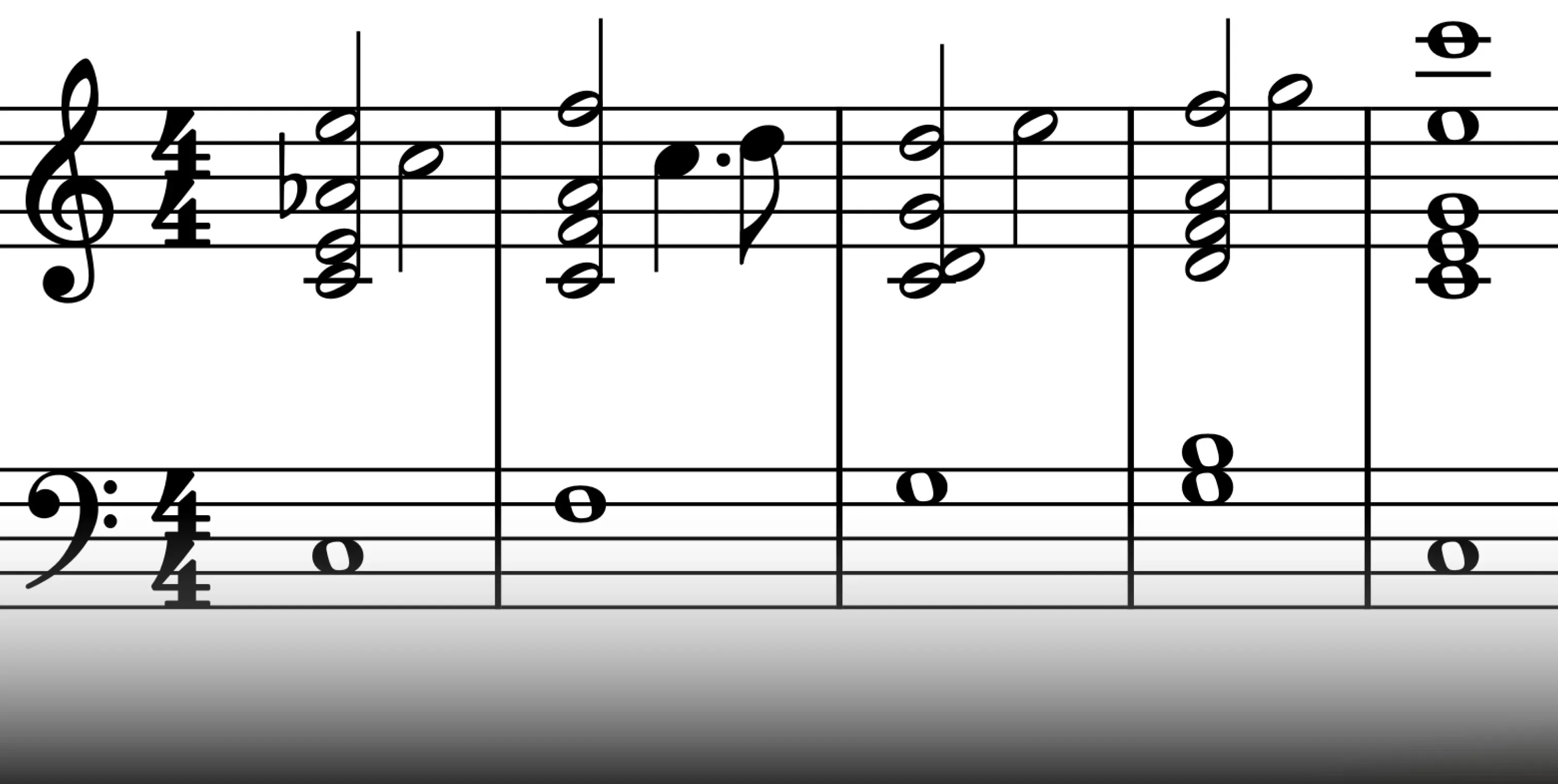
Chords: Caug - F - Gsus4 - G9 - C
Next, we’re using a Csus2 chord to maintain the tonic tonality while keeping the music moving forward.
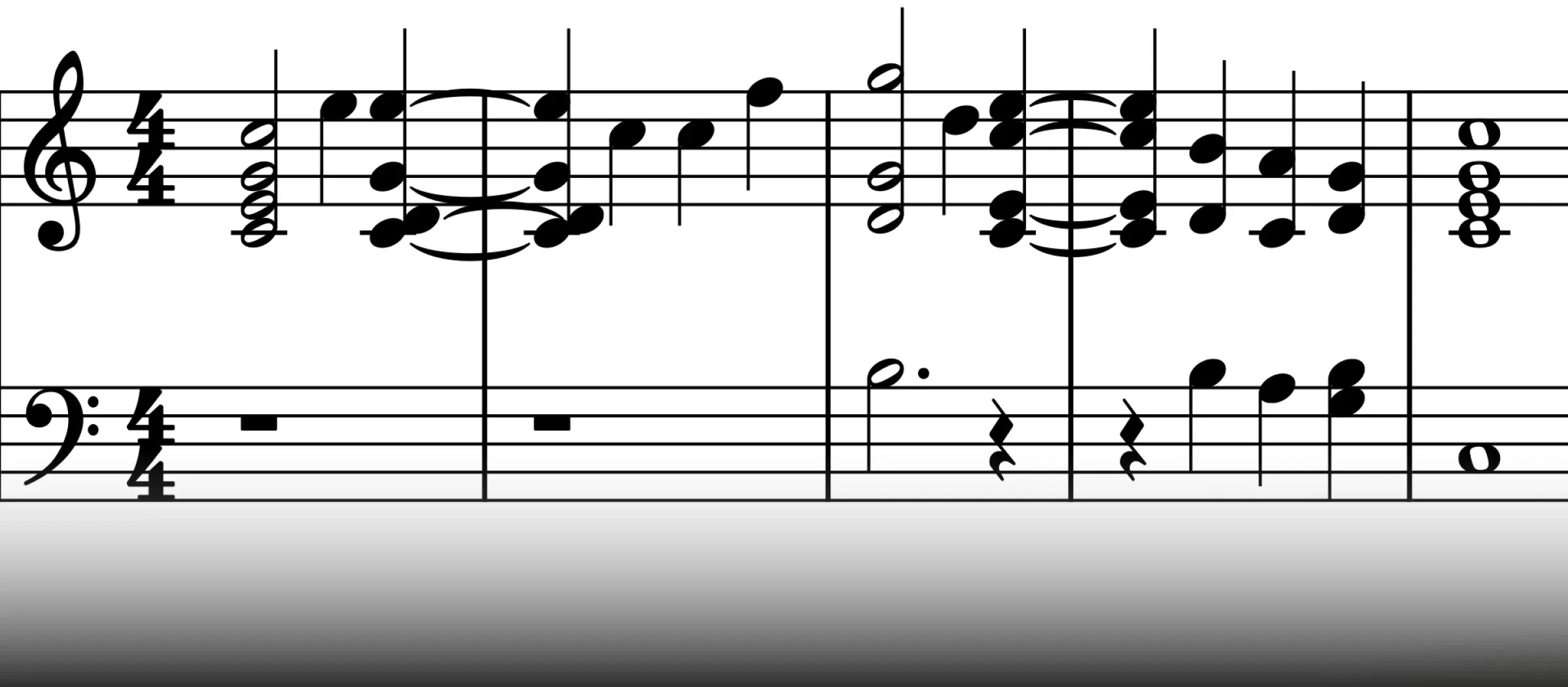
Chords: C - Csus2 - G - C - B - Am - G - C
The emotional impact of a suspended chord is highly contextual, shaped by the surrounding harmony, rhythm, and instrumentation. A Gsus4 chord played slowly on a piano in a C Major ballad might create a sense of gentle, unresolved yearning. That same Gsus4 played as a driving power chord on a distorted guitar can create powerful anticipation for a rock chorus.
While both sus2 and sus4 chords create harmonic suspension, they have different resolution tendencies.
The sus4 chord contains a stronger need to resolve. In a Gsus4 chord (G-C-D), the note C creates a dissonance that feels like it wants to fall down to the note B (the third of the G Major chord). This Gsus4 → G movement is a classic way to create and then release tension satisfyingly.
The sus2 chord, however, is less tense and more stable. A Csus2 chord (C-D-G) often doesn't demand a resolution back to a C Major chord. Its open, airy quality allows it to stand on its own or move freely to other chords in the key, adding a modern, spacious texture to a progression.
Power Chords
Rock music thrives on the raw energy of power chords. Unlike traditional triads, a power chord contains only two distinct notes: the root and the fifth. This creates a punchy, harmonically ambiguous sound that has become a cornerstone of the genre.
This stripped-down structure – lacking the third that would define a chord as major or minor – is what gives the power chord its strength and versatility. In C Major, the most common power chords would be:
- C5 (C and G)
- G5 (G and D)
- F5 (F and C)
The absence of the third is crucial when using high gain or distortion. Complex intervals can create unwanted dissonance and a"muddy"sound when amplified, but the pure interval of a perfect fifth in a power chord allows it to cut through the mix with clarity and force. This makes power chords instrumental in creating the signature sound of distorted guitar.
Beyond their powerful sound, power chords are incredibly player-friendly, especially on guitar. They typically use a consistent, movable hand shape across the fretboard, making them accessible and efficient for building the high-energy riffs and progressions that define rock music.
Unlock Harmonic Interest by Mastering Diatonic Chords
Mastering the concepts in this guide – from basic diatonic triads to the sophisticated colors of seventh, diminished, augmented, and suspended chords – unlocks a world of creative possibilities.
By understanding how these chords are formed, their unique tonal properties, and their diverse applications within the key of C Major, you are now empowered to add incredible depth, color, and intrigue to your music.
You no longer need to search for chords by trial and error; you can now build progressions with intention, crafting harmonies that perfectly match your creative vision.
Chord Inversions
A chord is in an inversion when a note other than the root is played as the lowest note (the bass). This simple change dramatically alters the character of the chord, as the bass note strongly influences the overall sound and feel of the harmony.
There are three main types of inversions:
- 1st Inversion: The third of the chord is in the bass. Example: A C Major chord (C-E-G) in 1st inversion has E in the bass and is written as C/E.
- 2nd Inversion: The fifth of the chord is in the bass. Example: A C Major chord (C-E-G) in 2nd inversion has G in the bass and is written as C/G.
- 3rd Inversion: The seventh of the chord is in the bass (This applies only to seventh chords). Example: A G7 chord (G-B-D-F) in 3rd inversion has F in the bass and is written as G7/F.
These inversions significantly impact the sound of a chord progression, adding smoothness, variety, and harmonic interest. In the following section, we'll explore the specific reasons why you would choose to use chord inversions in your music.
Creating Smooth Voice Leading
While the bass note defines a chord's inversion, the arrangement of all its notes is referred to as its voicing. One of the most important reasons to use inversions is to create smooth voice leading – the movement of individual notes from one chord to the next. By using inversions to minimize large leaps, you can create a more connected, stepwise, and musically pleasing flow.
This technique is crucial for creating a fluid and elegant harmonic texture, especially in arrangements with multiple instruments. Smooth voice leading prevents muddiness in the harmony and helps individual melodic lines blend into a cohesive and polished sound.
Let's look at a simple and common progression in C Major, C – Am – Dm – G – C, to see how inversions can create a smoother transition.
Example 1: Root Position Only
If you play all the chords in root position, the bass notes have to jump around significantly:
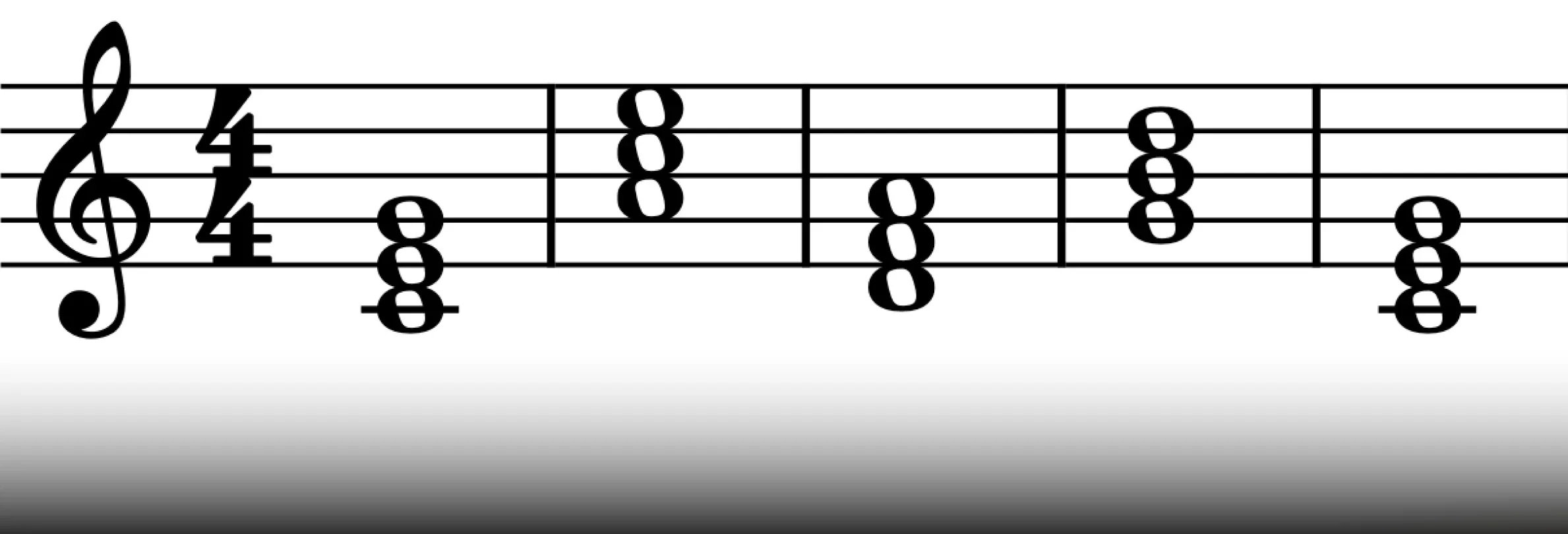
Example 2: Using Inversions for a Smooth Bassline
Chords: C → A/C → D → G/D → C Bass Notes: C → C → D → D → C
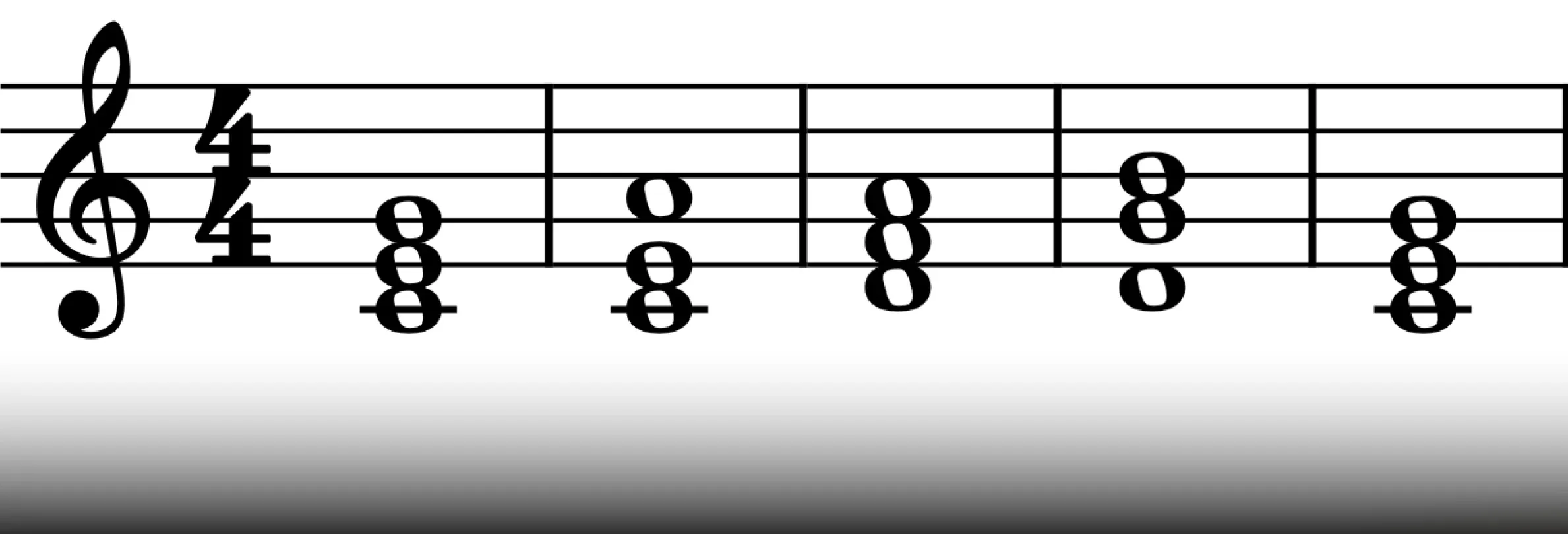
Now, let's use inversions to connect these same chords. Our goal is to create a descending, stepwise bassline.
Using a combination of root position chords and 1st and second inversion triads, we remove the jarring leaps between chords. Inversions not only sound more professional but also create a stronger sense of connection and flow between the chords.
How Inversions Affect Stability and Sound
Chord inversions create subtle but important shifts in a chord's stability and overall character. This is because the bass note acts as the foundation of the harmony, and changing it alters the chord's sound without changing its core identity.
Root Position: Maximum Stability
Root position chords, with the root note in the bass, sound the most stable and grounded. A C Major chord in root position feels solid and conclusive, making it a perfect choice for the final chord of a song.
Inverted Chords: Creating a Sense of Motion
Inverted chords, by contrast, feel less stable and often create a feeling of forward motion. This allows for harmonic variety and emotional nuance.
- 1st Inversion (e.g., C/E): This inversion often sounds brighter and lighter than the root position. Because the third is in the bass, it feels less grounded and as if it wants to move on to the next chord, making it perfect for use in the middle of a phrase.
- 2nd Inversion (e.g., C/G): This is typically the most unstable inversion of a major or minor triad. It is often used as a "passing chord" to create tension before a resolution.
Using inversions of the tonic chord is a powerful technique for creating nuanced approaches to your home key. Different inversions of the tonic offer varying degrees of stability, allowing you to subtly control the sense of resolution and arrival in your progressions.
Returning to the tonic with an inversion avoids the finality of the root position, creating a more fluid and sophisticated harmonic movement. It allows you to signal"home"without ending the musical sentence.
Using Tonic Chord Inversions
Using inversions of the tonic chord is a powerful technique for creating nuanced approaches to your home key. Different inversions of the tonic offer varying degrees of stability, allowing you to subtly control the sense of resolution and arrival in your progressions. Returning to the tonic with an inversion avoids the finality of the root position, creating a more fluid and sophisticated harmonic movement. It allows you to signal"home"without ending the musical sentence.
Practical Example in C Major
Imagine you are writing a verse that consists of several musical phrases. Instead of ending every phrase on a root-position C Major chord, which could sound repetitive, you can use inversions to vary the sense of closure:
- End of Phrase 1: Resolve to a C in root position. This firmly establishes the key and a sense of stability.
- End of Phrase 2: Resolve to C/E (1st inversion). This feels like a return home, but it's lighter and suggests the music is still flowing.
- End of Phrase 3: Resolve to C/G (2nd inversion). This is the most unstable inversion and can create a feeling of anticipation, perfectly setting up the dominant G chord to transition into a chorus.
By using inversions this way, you create a more dynamic and engaging listening experience. You firmly establish the tonal center while using the different" flavors" of the tonic chord to tell a more interesting harmonic story. This adds depth and richness to your music, moving beyond basic root-position progressions.
Learn How to Recognize Intervals
Practicing your interval recognition skills is the key to unlocking everything we've discussed. The ability to identify intervals by ear is what connects theory to practice, allowing you to build triads, form inversions, and use altered chords like diminished and augmented with speed and confidence.
For instance, when you can instantly recognize the sound of a major third versus a minor third, you can distinguish between a C Major and an E minor chord without hesitation. If you hear a melody in your head, recognizing the intervals allows you to find the notes on your instrument and harmonize them correctly, minimizing trial and error.
Training your ear to recognize the distinct sound of each interval grants you greater control over your music. It allows you to write more efficiently, make more informed harmonic choices, and ultimately express your musical ideas more accurately and effectively.
To help you develop this essential skill, our article “Ear Training: Songs to Practice Intervals” provides a curated list of famous songs that use each ascending and descending interval, making learning both fun and practical.
What’s next?
Learn how to write unique and interesting progressions for your next song with our comprehensive guide to “C Major Chord Progressions”. We look at how the chords of C Major are used in popular songs and explore interesting harmonic tricks to take your music to the next level.
This in-depth exploration of C Major harmony examines the effective use of both diatonic and chromatic chords, drawing inspiration from detailed analyses of hit songs in the key.
Discover how to inject intrigue and flavor into your music using techniques like tonic substitutions, secondary dominants, and other devices that create unexpected harmonic shifts to captivate your listeners. The guide also touches upon the use of key changes and modulation to further enhance the musical journey.
Musiversal: No Limit on Your Creativity
Turn your computer screen into a studio class. Collaborate and record your music with world-class musicians. With our Unlimited membership, you get unlimited recording sessions with over 80 professional artists. Work with them in real-time to make sure your musical vision is met.
Find the best musicians for your song, join the recording session live via a link, and collaborate in real-time to ensure your exact musical vision is met. With Musiversal, you have access to drummers, guitarists, string players, wind instrumentalists, beat-makers, pianists, percussionists, audio engineers, and much more.
You don’t need a complete song to start using the service. Work with our billboard-charting songwriters and take your music to the next level.
For valuable insights on music theory, songwriting, creativity, production, gear, marketing, and distribution, check out the weekly Musiversal Blog.
Stay informed and inspired. Sign up for our newsletter to receive exclusive session highlights, behind-the-scenes studio looks, and in-depth content. Get the most out of your Musiverse experience. Join now and don’t miss out!
Your Music, No Limits.
Join the Waitlist